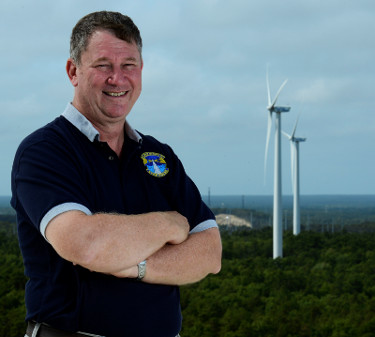 |
| November 18, 2014 | Volume 10 Issue 43 |
Designfax weekly eMagazine
Archives
Partners
Manufacturing Center
Product Spotlight
Modern Applications News
Metalworking Ideas For
Today's Job Shops
Tooling and Production
Strategies for large
metalworking plants
Air Force wind turbine helps power missile warning radar
By Kevin Elliott, Air Force Civil Engineer Center, Tyndall Air Force Base, FL

Steve Mellin, 6th Space Warning Squadron support officer, stands before two wind turbine power generators on Cape Cod Air Force Station, MA, Sept. 11, 2014. The turbines provide Cape Cod AFS with nearly 50 percent of its power needs and help save the Air Force more than $600,000 annually. [U.S. Air Force photo by Airman 1st Class Krystal Ardrey]
A wind turbine at Cape Cod Air Force Station, part of Joint Base Cape Cod, Mass., is partially powering one of the largest ground-based missile warning radars in the United States.
The 6th Space Warning Squadron at Joint Base Cape Cod operates the Phased Array Warning System, named PAVE PAWS. The radar operates around the clock and has a 3,000-mile reach down the east coast and over the Atlantic Ocean.
Although its main purpose is to detect submarine-launched ballistic missiles, PAVE PAWS also tracks satellites in low-Earth orbit. To achieve this range, the radar requires massive amounts of energy, amounting to a $1.6 million annual electric bill.
"We are one of the largest energy consumers on the Cape," said Stephen Mellin, support officer for the squadron. "Most of the energy used on the site is directly related to the radar itself."
In an effort to reduce its energy intensity, the 6th SWS partnered with Air Force Space Command and the Air Force Civil Engineer Center to install two 1.68-megawatt wind turbines on the site.
"Cape Cod is a really good place to put wind turbines," Mellin said. "Our wind resources are some of the best in the country."
The energy produced by the turbines is sold directly to the local utility company and, in return, the 6th SWS receives energy credits back on its bill.
"In the first six months of operation, the project generated $668,068 in credits," said Fox Theriault, energy analyst at AFSPC. "When you look at this project and the money it is saving, the impact is huge. Projects like this help us achieve energy goals with visible savings."
The $8.5 million project was funded by the energy conservation investment program, a subset of the military construction program. ECIP was created to fund military projects that save or produce energy on military sites, thus reducing Department of Defense energy costs.
The payback period for the PAVE PAWS wind turbine is eight to10 years. The lifespan of the turbine is twice that.
"The wind turbines have a 20-year life expectancy," Mellin said. "So we're looking at half of their time up here being past the payback period."
The 6th SWS and AFSPC also worked with Cape Light Compact and the local utility company to complete a site energy audit in order to identify other energy-saving opportunities.
"We changed light bulbs from T12s to energy-efficient T8 bulbs, we put variable-frequency drives on our equipment to save energy, and even changed out the old exit signs with new LED signs," Mellin said.
"Space Command was the first in the Air Force to replace old technology parking and roadway light fixtures with new state-of-the-art LED fixtures," Theriault said. "The fixtures have been 100-percent maintenance-free and provide much better lighting for the security personnel."
The effort has helped the 6th SWS achieve its energy goals.
"We conducted $300,000 worth of energy-efficiency upgrades that have saved more than $150,000 annually, which amounts to a two-year payback period, all at no cost to taxpayers," Theriault said.
Even with all of these successes, the 6th SWS is always looking for new ways to save energy.
"We are trying to be very proactive about energy savings, looking for whatever conservation measures we can find to do," Mellin said.
Published November 2014
Rate this article
View our terms of use and privacy policy
